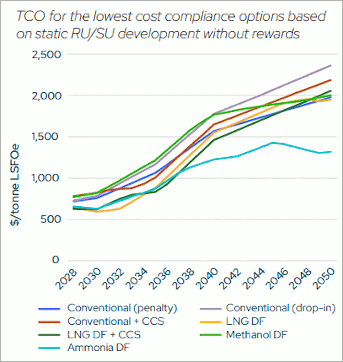
The new policy measures defined by the International Maritime
Organization (IMO) to decarbonize shipping are
ambitious enough to lead the transition to
zero-emission scalable fuels, but these fuels will have
success only if they benefit from significant incentives and, in the
time, for harsher penalties for non-compliance.
This is highlighted by a new report by the Getting to Zero Coalition and the
Global Maritime Forum (GMF) which highlights how fuels
scalable zero-emission devices such as green ammonia and methanol
have the highest potential to enable
achieve the industry's 2040 targets, but their supply chains
of value must be developed within the next decade to
ensure their commercial viability.
The report "IMO's policy measures: What's next for
shipping's fuel transition?" specifies that the forecasts
based on the Total Cost of Ownership methodology of
UMAS and UCL and over 30 interviews with stakeholders to
analyze the capital investments and operational options of the
following the adoption by the IMO of the
Global Fuel Intensity (GFI) and penalties for non-compliance
notes that dual-fuel vessels powered by liquefied natural gas and
ammonia will be the most competitive options in terms of
costs by the mid-1930s, with ammonia
will take over from approximately
2037.
The document specifies that, although there are many different types of
compliance pathways with respect to IMO standards, the increasing
severity of the GFI and higher penalties will favor
scalable zero-emission fuels,
moving the industry away from fuel-based options
such as liquefied natural gas and directing it towards fossil fuels
e-fuels based on green hydrogen. Thus highlighting that the
e-fuels offer maritime transport the most
high in achieving its decarbonisation targets to
the analysis makes it clear that adoption is needed
and the development of the value chain so that
achieve commercial viability in good time.
 The analysis explains that TCO modelling reveals that,
even without incentives to stimulate the uptake of e-fuels,
it is likely that in the next decade fuels
will be significantly more expensive than gas
liquefied natural and ammonia. LNG will have the cost
between 2030 and 2035, although this
This could extend to 2037 thanks to the use of
carbon capture and storage systems on board ships.
On the other hand, ammonia, in particular blue ammonia, is
destined to become the most competitive option in terms of
costs from 2037. The report notes that, given the long
duration of these investments, it is likely that orders of
ammonia-fuelled dual-fuel ships are already becoming
today the competitive choice. However, to ensure that alternatives
scalable to e-fuel are ready in time, IMO guidelines
should introduce incentives to ensure their competitiveness
already today.
The analysis explains that TCO modelling reveals that,
even without incentives to stimulate the uptake of e-fuels,
it is likely that in the next decade fuels
will be significantly more expensive than gas
liquefied natural and ammonia. LNG will have the cost
between 2030 and 2035, although this
This could extend to 2037 thanks to the use of
carbon capture and storage systems on board ships.
On the other hand, ammonia, in particular blue ammonia, is
destined to become the most competitive option in terms of
costs from 2037. The report notes that, given the long
duration of these investments, it is likely that orders of
ammonia-fuelled dual-fuel ships are already becoming
today the competitive choice. However, to ensure that alternatives
scalable to e-fuel are ready in time, IMO guidelines
should introduce incentives to ensure their competitiveness
already today.
"The new IMO regulatory framework is a step forward
- explained Jesse Fahnestock, director for the
decarbonisation of the Global Maritime Forum - however, if the
e-fuels do not become competitive in a short time, there is the
risk that the sector will run into bottlenecks with
the intensification of decarbonization efforts".
"Taking into account the demand for decarbonisation
In the long term, he added, order dual-fuel ships capable of
Running on e-fuel already seems like a decision
intelligent. But future policy adjustments can be made
much to encourage investment in production facilities
e-fuel".
"Now," Fahnestock concluded. We have a base
legislation, but further developments and adjustments are needed
for e-fuels to become sustainable in a phase
early enough to achieve the ambitions of
decarbonization of the sector. Although doing nothing is no longer
one option, the rules must still be defined in such a way as to
incentivise the investments needed for the future of transport
maritime".